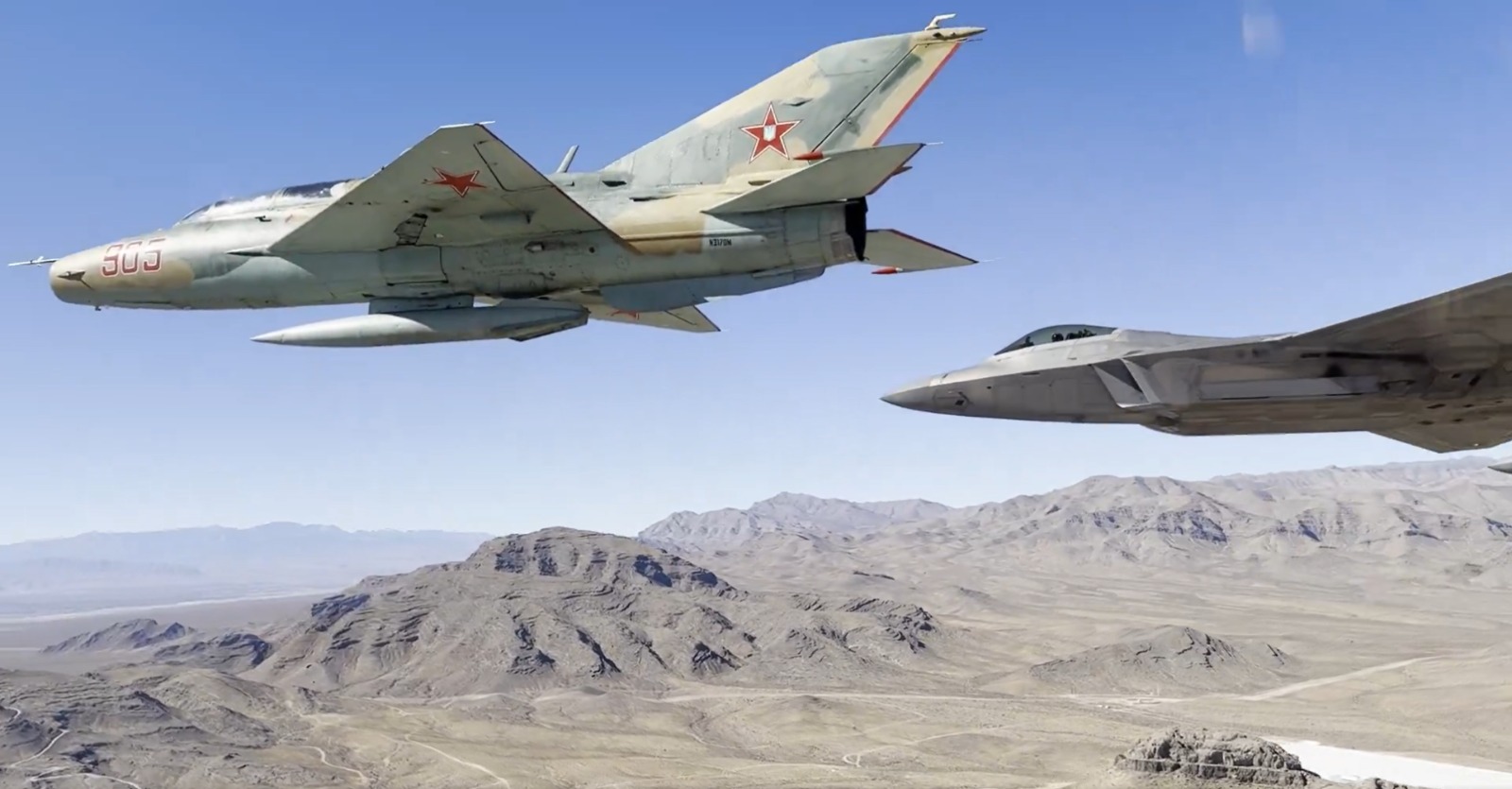Two F-22 ‘Raptor’ soaring high in the sky, flanked by a MiG-21 and a MiG-29. No, the Russian fighter jets did not scramble to attack the American F-22 ‘Raptors’.
A newly released video provided a sneak peek into the US Air Force’s secret unit, nicknamed the “Red Eagles,” which helped train its pilots to fight against Soviet fighter jets.
The Soviet fighter jets have been part of the US’s secret program, Project Constant Peg, which trains the US Air Force, Navy, and Marine Corps fighter aircrews to fly against Soviet combat sets. The clandestine USAF’s 4477th Test and Evaluation Squadron (TES) was given the name “Red Eagles”.
The squadron consisted of MiG-17 “Fresco,” MiG-21 “Fishbed,” and, in the 1980s, MiG-23 “Flogger” aircraft, acquired by the US intelligence services and restored in the US for flight. Red Eagles’ pilots not only used Soviet tactics but also flew the same formidable MiG series fighter jets they would face during the conflict.
When Israel Bombed U.S. Navy Warship! Recalling When IAF Fighter Jets Pounded American Vessel, Killing 34 Crew Members
The video was released on X and shows an aircraft formation consisting of two USAF F-22 Raptors and Soviet-era MiG-21 and MiG-29 of the Red Eagle squadrons. The formation marked the passing away of the first commander of the 4477th Test and Evaluation Squadron, Colonel Gail Peck (retired).
If you need a distraction..and I do..I just found out we can share this from last year. A memorial flyover for Col. ‘Evil’ Peck, first commander of the secretive Red Eagles. Mig-21 leading, I was flying the Mig-29 along w/F-22s. You will never see a formation like this again. pic.twitter.com/8ifY1ffvk1
— Jared Isaacman (@rookisaacman) June 8, 2025
The video mentioned above was shared by Jared Isaacman, an American billionaire entrepreneur, pilot, and commercial astronaut. He is the founder of Draken International, which provides adversary training to the US Air Force and its NATO allies. Isaacman was flying the MiG-29UB Fulcrum-B that captured the video, where a MiG-21 and two Raptors can be seen. MiG-21 was leading the formation.
Sharing the video, Isaacman wrote: “If you need a distraction… and I do … I just found out we can share this from last year. A memorial flyover for Col. ‘Evil’ Peck, first commander of the secretive Red Eagles. Mig-21 leading, I was flying the Mig-29 along w/F-22s. You will never see a formation like this again.”
In 1968–69, Gail Peck’s ‘Bandit-1’ flew 163 combat missions during the Vietnam War, many of which were conducted at night, and he was awarded the Silver Star and three Distinguished Flying Crosses.
Why Alien & UFO Sightings Are Highest In The U.S.? New Research Answers The Intriguing Question!
He subsequently served as an instructor in the MiG-17 and later both the F-5E and MiG-21 as a ‘Red Eagles’ aggressor pilot in the Constant Peg.
Project Constant Peg was established in 1977 and was meant to apply lessons learned in Southeast Asia. Over North Vietnam, the USAF and USN (US Navy) had faced high losses to enemy aircraft, air-to-air missiles, and surface-to-air missiles. These losses sharply illustrated training shortfalls and a loss of skill in the art of the “dogfight,” as the website of the National Museum of the United States Air Force reads.

The USAF personnel selected for the secret training program were in for the shock of their lives when they saw their first Red Eagles approaching during the initial flight training missions. The first MiG exposure for USAF pilots began with a radar intercept and formation flight, showcasing the capabilities of the MiG fighter jets. This introduction aimed to eliminate “buck fever” – the pilot’s shock at seeing a MiG up close for the first time.
“Whenever a US pilot swept in over the desert, the first thing he noticed was how truly small the MiGs were. Their engines didn’t smoke, and they didn’t swiftly change from tiny dots into giant fighters, as was true of the US aircraft. To find these MiGs, you had to visually scour small sections of the Nevada sky.”
Constant Peg was terminated in 1988, and the 4477th TES was inactivated in 1990 in a funding drawdown at the end of the Cold War.
The MiGs In The USAF
The intrigue for Russian fighter jets has been there since the Cold War Era.
The US military and intelligence agencies have for decades scoured the world for access to everything from captured surface-to-air missiles to bits and pieces of spacecraft that have fallen to Earth and wreckage of Russian fighter jets.
China Adopts “Israel Model” To Checkmate India; Can Beijing Emulate The U.S. To Keep Delhi Restrained? OPED
And all with one intention — to learn valuable things about America’s adversaries. “Foreign Military Exploitation” (FME) has long been a part of the intelligence-gathering repertoire, but it has been the least written about subject, as most of its activities remain classified.
The US had the opportunity to study the MiG-21 when one of the first Soviet-made jets landed in central Israel on August 16, 1966, piloted by an Iraqi defector, Munir Redfa. When touching Israel, the jet wore its Iraqi Air Force markings, carrying the Arabic serial number “534” on its nose.
At the time, the Israeli Air Force had nothing comparable to the MiG-21 — it was equipped with slower French-made Vautours and Mirage IIIC fighters. A 20-year arms embargo imposed by the US Congress had denied Israel modern aircraft such as the Lockheed F-104 Starfighter and the newer McDonnell Aircraft F-4 Phantom.
After the Israelis finished studying the MiG-21, the aircraft was transferred to the US government’s secret Nevada airfield, colloquially known as Area 51. Redesignated as the YF-110, the Fishbed was evaluated here under Project Have Doughnut.
At this time, the MiG-21 was giving hellfire to the US aircraft in Vietnam — the Have Doughnut project aimed to formulate offensive and defensive tactics from extensive tests on the MiG-21.
The MiG-23 was acquired by the Central Intelligence Agency (CIA) from the Egyptian government. Under the project name HAVE PAD, the Red Hats would reassemble the Flogger, conduct a wide array of non-destructive testing on it, and then extensively test fly it to reveal its strengths and weaknesses – handling qualities, range, endurance, max climb rate, sustained turn rates, and so on.
U.S. Air Force “Shoots Down” U.S. Navy Aircraft Yet Again As Pentagon Prioritizes F-47 Over F/A-XX Program
The US got 17 more (11 MiG-23MS and 6 MiG-23BN), the first twelve of which were shipped to the US in two C-5s, each carrying six airframes. There was indeed a quid pro quo.
In 1979, Egypt received a comprehensive Foreign Military Sales package valued at US$594 million, known as the “Peace Pharaoh,” consisting of F-4E Phantom II jet fighters and, later, the F-16 Fighting Falcon.
The biggest prize of the Cold War’s end was the opportunity to acquire the MiG-29 Fulcrum – a twin-engine fighter jet developed by the Soviet Union in response to US fighters like the F-15 Eagle and the F-16 Fighting Falcon.
The MiG-29’s maiden flight in 1977 was a demonstration, as US defense experts observed that the MiG-29 had come a long way from its predecessors, and the Soviets were catching up with US aircraft technology.
The collapse of the USSR presented an opportunity for the US military to acquire Soviet-era MiG-29s from a small country, the Soviet Republic of Moldova. In a deep recession, the country agreed to sell most of its MiG-29 Fulcrum fleet to the United States.
The MiG-29 was a maneuverable, deadly aircraft for its time. Its Archer AA-11 missiles were sophisticated for the 1990s because they could lock targets with a helmet-mounted cueing system at greater angles away from the jet’s nose than comparable American fighters. The US acquired 21 fourth-generation fighters from Moldova, which had 34 MiG-29s.
The fear that economic needs would make Moldova sell these fighter jets to the Islamic Republic of Iran prompted the US to shell out money comparable to that of any US plane. Once the aircraft reached the US, their airframes were deconstructed and their capabilities tested.
- Views Personal of the Author


